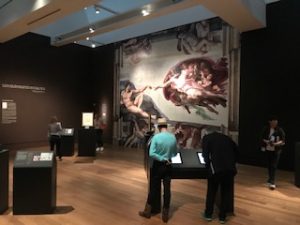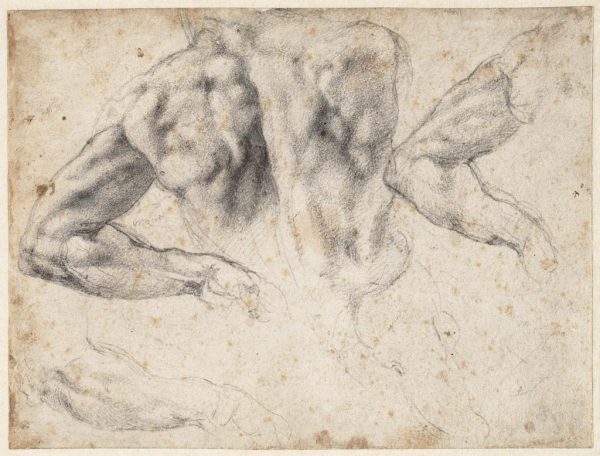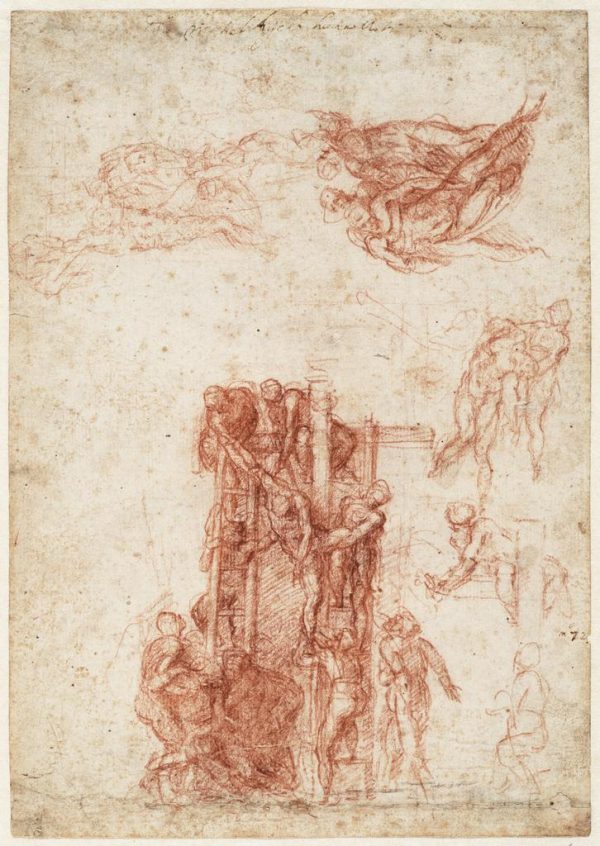
Editor’s Note: This exhibition was reviewed before The Getty closed due to coronavirus.
When in the presence of genius, you know it!
This exhibition of Michelangelo’s drawings presents a collection of his drawings from the Teylers Museum, Haarlem, the Netherlands supplemented with drawings from the Cleveland Museum and the J.Paul Getty Museum. It provides a unique opportunity to view and understand one aspect of this master’s extensive creativity.
Michelangelo, a painter, sculptor, architect and draughtsman, created a legacy of astonishing virtuosity in 16th century Florence and Rome that has hardly been diminished over five centuries. Recognized for his genius in his own time, his reputation persists as one of the most creative individuals in Western European art.
His heroic 17 foot marble statue of the biblical hero David stood outside the Bargello in Florence from 1504 until recently when it was moved inside to protect it from air pollution. His frescoes for the Sistine Chapel at The Vatican are a colossal work of art for which there is no equal. His design for the grand stairs and three buildings at the Capitoline Hill in Rome stand with eloquence above the remnants of the neighboring Roman Forum.

For him, drawings were the foundation of his creativity. Extensive groups of drawings were a preliminary to everything that he created: architecture, paintings, and sculpture. However, he did not consider his drawings to be distinguished works of art – often destroying them soon after completion. He, like other artists of his generation, would dissect human corpses in oder to understand how muscles functioned below layers of skin. There are several such drawings in this exhibition.
For his earliest drawings, he used mainly pen and ink. Later he used naturally mined red and black chalk. Drawings in this exhibition represent various methodologies: pen and brown ink, red and black chalk, and sometimes watercolor. He used both sides of sheets of paper. These drawings are displayed here so that both sides are visible.
Giorgio Vasari, painter, architect, author, and historian, was a contemporary colleague and friend of Michelangelo. Vasari’sThe Lives of the Most Excellent Painters, Sculptors, and Architects, published in 1550, is a defining document of the Italian High Renaissance chronicling the lives and work of the major artists of the early 16th century in Italy. Among them, Vasari’s Life of Michelangelo remains, after five centuries, a rich and compelling treaties on Michelangelo and his work. Following are some excerpts.

“The genius of Michelangelo was recognized in his lifetime, and not, as happens to many, after death. For it has been seen that Julius II, Leo X, Clement VII, Paul III, Julius III, Paul IV, and Pius IV, all supreme Pontiffs, always wished to have him near them. And also, as is known, Suleiman, Emperor of the Turks, Francis of Valois, King of France, the Emperor Charles V, the Signoria of Venice, and finally, as has been related, Duke Cosimo de’ Medici; all offering him honorable salaries …
“He told me that often in his youth he slept in his clothes, being weary with labor and not caring to take them off only to have to put them on again later. There are some who have taxed him with being avaricious, but they are mistaken, for both with works of art and with his property he proved the contrary…
“This sober life kept him very active and in want of very little sleep. Often during the night, not being able to sleep, he would rise to labor with the chisel; having made a cap of thick paper, and over the center of his head he kept a lighted candle, which in this way threw light over where he was working without encumbering his hands. I, who had seen the cap several times, reflecting that he did not use wax, but candles of pure goat’s tallow, which are excellent, sent him four bundles of these, which weighed thirty pounds…
“Michelangelo was a man of tenacious and profound memory, so that, on seeing the works of others only once, he remembered them perfectly, and could avail himself of them in such a manner, that scarcely anyone has ever noticed it. Nor did he ever do anything that resembled another thing by his hand, because he remembered everything that he had done …
“Michelangelo abandoned his works — nay, destroyed many of them. I know that a little before he died he burned a great number of designs, sketches, and cartoons made with his own hand, to the end that no one might see the labors endured by him and his methods of trying his genius, and that he might not appear less than perfect. Of such I have some by his hand, found in Florence, and placed in my book of drawings. From these, although the greatness of that brain is seen in them…”
This exhibition was organized by the Getty Museum in cooperation with the Cleveland Museum of Art and the Tylers Museum, Haarlem, the Netherlands.
(Featured image: Left: Studies of the Upper Body of a Man, and Separate Studies of an Arm, a Hand, and an Ear; Sketch of a tree (detail), 1511–12, Michelangelo Buonarroti, red and black chalk. Right: Seated Male Nude, and a Study of His Right Arm (detail), 1511, Michelangelo Buonarroti, red chalk, heightened with white. Both Images: Teylers Museum, Haarlem. Purchased in 1790. © Teylers Museum, Haarlem)
